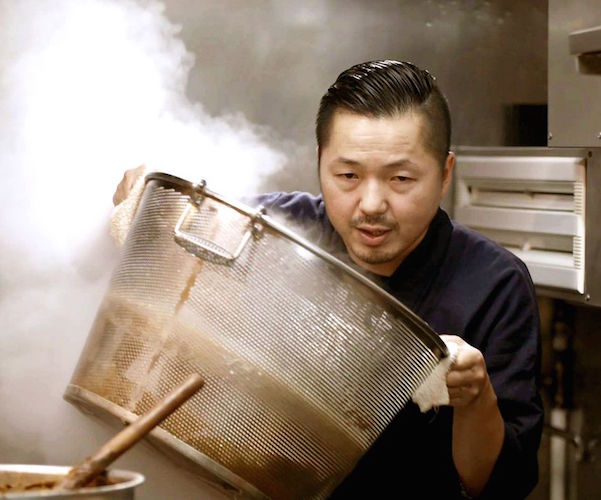Film Review: “Ramen Heads” — Delicious Obsession
Food porn? You know it when you see it.
Ramen Heads directed by Koki Shigeno. Screening at Kendall Square Cinema.

A scene from “Ramen Heads.”
By Gerald Peary
I won’t forget the afternoon 31 years ago when I somehow walked into a yakitori restaurant under a railroad trestle in Tokyo. Lucky me, soon gnawing on amazing hacked chicken pieces brushed with soy sauce and mirin. The man on the next stool well understood my appreciation. “This is the best yakitori restaurant in Tokyo, “ he bragged of why he regularly sought out this squat, anonymous spot. “And it’s the best yakitori in Japan. Thus the best yakitori in the world.”
To their credit, many Japanese obsess about what goes into their stomachs. They are understandably responsible for the best food movie ever. I mean the 1985 narrative, Tampopo, set in a faltering Tokyo restaurant, about the lunatic attempts in the kitchen to bring life to the moribund ramen broth. The 2011 American-made documentary, Jiro Dreams of Sushi commemorated Jiri Ono, 85, Tokyo’s legendary sushi chef, whose very existence is tied to each day purchasing from the market the freshest seafood and orchestrating for his customers the most sublime plate of sushi on earth. And now from Japanese director Koki Shigeno’s comes Ramen Heads, an amiable if derivative documentary which survives an imposed English voice-over more suited to a commercial and a horn-heavy music track more appropriate for The Crown. It combines the ramen obsession of Tampopo with Jiro Dreams of Sushi’s strategy of celebrating a Japanese master chef who lives and dies for his restaurant.
The protagonist of this food-mad documentary is Osamu Tomita, whose nondescript eating establishment in the suburbs of Tokyo has lines around the block from early morning. People are hurting to get in, to be granted a coveted counter seat for lunch and savor the transcendent ramen dishes. Tomita has won “Best Ramen in Japan” for an impossible four years in a row. To accomplish this, he’s a control freak who is in his restaurant every minute of every day that it’s open, ruling over his cowed interns (future ramen chefs), and hyper-managing every bite of the food that makes it into his award-winning recipes. “With boiling noodles, ten seconds too long and you ruin them,” he declares. Not only are his noodles made from scratch, from four kinds of special flour, but, post-boiling, they are, like laundry, scrubbed by hand in a cold wash, and then the superlative flavor locked in with a quick dip into ice.
'Ramen Heads' combines the ramen obsession of 'Tampopo' with 'Jiro Dreams of Sushi’s strategy of celebrating a Japanese master chef who lives and dies for his restaurant.Click To TweetOh, the mesmerizing, tantalizing broth, which Tomita admits is raw and adventurous, not for the mainstream and timid. All kinds of things can be dropped in there, from chickens to a gamey pig head to a whole dried fish to pulverized mackerel. It looks like caramel-colored glop but it’s deliciously tasteful when, besides the noodles, Tomita tosses in seaweed, a fish cake, green onions, bamboo shoots, and marvelously marbled pork slices.
His restaurant is closed for dinner. Tomita waits until shutting time, 5:30, before, each day, he samples what he’s cooked. It’s fun and instructive to watch how he does it. First, he tastes some broth. Then he attacks the noodles with noisy, aggressive slurps. “Noodles must have ‘slurpability,’” he attests. “We want people to slurp the hell out of our noodles. They are like firecrackers in your mouth.” But he doesn’t immediately swallow what he has slurped. The next step: he vigorously chews the noodles which fill his mouth. And then it’s time to munch down whatever. But the final moment of eating is done without chopsticks, or politeness. He leaves a little broth, raises the bowl to his mouth for a sensuous gulp. “He works with his ears, eyes, and nose,” says one of his awed chefs-top-be.
Food porn? You know it when you see it. Ramen, we learn, has been on Japanese menus since around 1910; but it became really popular in the hard years after World War II. It was a people’s food long before celebrity chefs like Tomita arrived on the culinary scene, before fetishist, yuppie-adopted ramen restaurants got Michelin ratings. As another ramen cook in the movie notes, “Originally it was just a workingman’s meal, food for your belly which you could eat quickly and [go back] to work.”
Gerald Peary is a retired film studies professor at Suffolk University, Boston, curator of the Boston University Cinematheque, and the general editor of the “Conversations with Filmmakers” series from the University Press of Mississippi. A critic for the late Boston Phoenix, he is the author of nine books on cinema, writer-director of the documentaries For the Love of Movies: the Story of American Film Criticism and Archie’s Betty, and a featured actor in the 2013 independent narrative Computer Chess.
